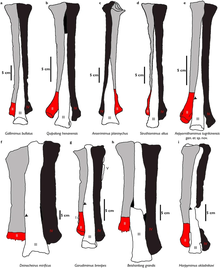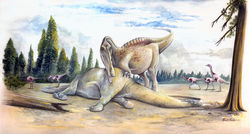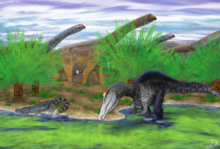Kinnareemimus
| Kinnareemimus Temporal range:Early Cretaceous
~125 to 120 Ma - Late | |
|---|---|

| |
| Hypotheticallife reconstructionof threeKinnareemimus | |
| Scientific classification | |
| Domain: | Eukaryota |
| Kingdom: | Animalia |
| Phylum: | Chordata |
| Clade: | Dinosauria |
| Clade: | Saurischia |
| Clade: | Theropoda |
| Clade: | Maniraptoriformes |
| Clade: | †Ornithomimosauria |
| Genus: | †Kinnareemimus Buffetautet al.,2009 |
| Type species | |
| †Kinnareemimus khonkaenensis Buffetautet al.,2009
| |
| Synonyms | |
| |
Kinnareemimus(/ˌkɪnəriˈmɑːiməs/,meaning "Kinnareemimic ", after a figure from Thai folklore) is anextinctgenusofornithomimosauriantheropoddinosaurthat was discovered in theEarly CretaceousSao Khua Formationin what is nowThailand.The genus contains only thetype species,K. khonkaenensis.The specific epithet is afterKhon Kaen Province,which is in northeastern Thailand, where the remains of the animal were discovered.[1]
Discovery and naming
[edit]

Ornithomimosaurbody fossilsandichnofossilswere reported inThailand'sKhorat Plateauas early as 1997 in a publication by Eric Buffetaut and colleagues. At the time, only two dinosaur genera,SiamotyrannusandPhuwiangosaurushad been named from the country. Their report included a drawing of themetatarsalsof an ornithomimosaur which had been uncovered at a locality called "Phu Wiang 5". These metatarsals clearly showed the derived arctometatasalian condition, similar to the ornithomimosaurs known fromLaramidia.However, this specimen was not identified by any name other than the "Thai ornithomimosaur".[2]
The next mention of the "Thai ornithomimosaur"[3]was in the first edition of the Dinosaur Press magazine, which was published inJapanin 2000.[3]In this publication, the taxon is referred to by thenomen nudum"Ginnareemimus" by Ryuichi Kaneko, who wrote an article in the magazine which contained recent information aboutpaleontology in Thailand.[4][5]
Kinnareemimusreceived a formalspecies descriptionin2009when Eric Buffetaut, Varavudh Suteethorn, and Haiyan Tong published an anatomical monograph in the bulletin of theGeological Society of London.All the bones referable to ornithomimosaurs found at Phu Wiang 5 were disarticulated, and it is therefore impossible to know exactly how many individual animals were fossilized at the site. For this reason, whenKinnareemimuswas described in 2009, only a single partial metatarsal III — designated PW5A-100 — was designated as theholotype.The remaining specimens were each given unique designations (from 101 to 131), and they were each referred to the new genus. Buffetaut and Suteethorn remark in their description that they are confident that all of the material belongs to a single species, but they conservatively did not include the anatomy of these bones in the species diagnosis.[1]
When it was described, the authors named the genus afterKinnaree,a being from the folklore of theThai peoplewhich has the head and torso of a woman and the legs of a bird and lives in the legendary Himmapan Forest. Buffetaut and Suteethorn remark that the choice of Kinnaree was in reference to the birdlike feet ofKinnareemimus.[1]
Description
[edit]Because theholotypeofKinnareemimusis so fragmentary (consisting of only a singlemetatarsal), estimates of the animal's size have always been highly speculative and uncertain. The authors who described the genus, Eric Buffetaut and colleagues, did not give an estimate of the animal's mass. They remarked that the ratio of the lengths between thetibiaand the third metatarsal ofKinnareemimusis most similar toGarudimimus.They interpret this to mean that its body proportions may have been more similar to that genus than to derived genera likeGallimimusorStruthiomimus.[1]It has subsequently been estimated by Molina-Pérez and Larramendi to have been about 1.8 metres (5.9 ft) long and would have possibly weighed around 13 kilograms (29 lb).[6]
Holotype
[edit]| Specimen | Includes |
|---|---|
| PW5A-100 | distal portion of a left metatarsal III |
| PW5A-101 | left metatarsal II |
| PW5A-102 | proximal portion of a left metatarsal IV |
| PW5A-103 | middle portion of a left metatarsal III |
| PW5A-104 | proximal portion of a left metatarsal III |
| PW5A-105 | most of a left metatarsal II |
| PW5A-106 | right metatarsal IV |
| PW5A-107 | distal portion of a right metatarsal III |
| PW5A-108 | proximal portion of metatarsal IV |
| PW5A-109 | proximal portion of metatarsal IV |
| PW5A-110 | right tibia |
| PW5A-111 | left tibia |
| PW5A-112 | proximal portion of a left fibula |
| PW5A-113 | proximal portion of a right pubis |
| PW5A-114 | proximal portion of a left pubis |
| PW5A-115 to 121 | pedal phalanges |
| PW5A-122 | partial pedal phalanx with an ungual |
| PW5A-123 | dorsal vertebral centrum |
| PW5A-124 | partial caudal vertebra |
| PW5A-125 | middle caudal vertebral centrum |
| PW5A-126 to 129 | distal caudal vertebrae |
| PW5A-130 | proximal caudal vertebral centrum |
| PW5A-131 | proximal portion of a right metatarsal III |
The holoytpe ofKinnareemimus(PW5A-100) is a partially complete thirdmetatarsalthat preserves the articular surface on the left side. The incompleteness of the specimen made it difficult for Buffetaut and colleagues to estimate the full size of the bone. However, another specimen (PW5A-101), is a second metatarsal of similar size and robustness, and is much more complete. The authors describing it believe it may have belonged to the same individual, and so they used it to estimate a full-length of the third metatarsal to have been roughly 145 millimetres (5.7 in) in life.[1]
This specimen was used to diagnoseKinnareemimusas distinct from all otherornithomimosaursbased on the followingapomorphies:a semi-arctometatarsalian condition where the third metatarsal is still visible in proximal view and which narrows in the distal direction before flaring into a wider triangular cross-section at the distal-most end.[1]This diagnosis was amended in2024by Samathi to include ventrally-flattened pedal unguals with flexor fossae, which supported the inclusion ofKinnareemimuswithin ornithomimosauria.[7]
Referred specimens
[edit]- Axial skeleton
The only parts of the axial skeleton ofKinnareemimuswhich are preserved are eight vertebrae from various parts of the spine (one putativedorsal vertebraand sevencaudal vertebra). The single non-caudal vertebra (PW5A-124) was inferred to be a dorsal vertebra because it lacks the articular facets forchevrons,although this is not known for certain. The neural arch for the vertebra is not preserved and the portion of the bone missing corresponds to the location of the unfused sutures in an immature individual, which led the authors to suggest the specimen came from a juvenile individual.[1]
The caudal vertebrae which are assigned toKinnareemimusare from several distinct individuals. Thecentraare hourglass-shaped and hollow with no transverse processes, resembling the condition seen inGallimimus.Some of the preserved vertebrae have differing cross-sectional shapes, and probably come from different sections of the tail. At least one (PW5A-130) may be a first caudal vertebra. The seven vertebrae preserved from other parts of the tail display varying degrees of fusion, indicating these specimens are from a multi-age assemblage.[1]
- Appendicular skeleton
Most of the remains discovered at Phu Wiang 5 are bones from the hind-limbs or hips of various individuals. Two partialpubic bonesare preserved which are very slender in comparison to similarly sized pubic bones of similarly sizedornithomimosaurs.Buffetaut and colleagues remark that this may not be a true apomorphy but instead an artifact of the individuals'ontogeny.[1]
Twotibiaewere preserved in the type locality. They are similar in length and one is from a right leg and the other is from a left leg. However, they are believed to be from different individuals because of differences in robustness between the two which are possibly a result of ontogeny. The general shape of the tibiae resembles primitive ornithomimosaurs with few distinguishing features. The singlefibulawhich is preserved is only partially complete and preserves a broad and deep groove along the shaft which resembles the condition inGallimimus.The preservedphalangesare similar in shape toGarudimimusandHarpymimus,but they are more slender. The single partial toe claw that is preserved lacks a flexor tubercle, analogous to the third ungual inStruthiomimus.[1]
The majority of the remains ofKinnareemimusaremetatarsalbones, which come from the lower part of the leg just above the foot. The metatarsals of several individuals are known, which allows the metatarsus to be reconstructed with reasonable precision. A notable feature is the presence of anarctometatarsalian conditionwhich is similar to that of derived ornithomimids andtyrannosauroids.However, the third metatarsal was not fully enclosed by the proximal ends of the second and fourth metatarsals, so it was not a true arctometatarsus.[1]
Classification
[edit]AlthoughKinnareemimusis relatively fragmentary, the available evidence from reconstructions of the metatarsals allows its relative evolutionary position withinOrnithomimosauria.The development of thearctometatarsusis roughly linear within the phylogenetic topology of ornithomimosaurs. From this, it has been inferred thatKinnareemimusis in a more derived position thanGarudimimus,but less derived thanOrnithomimidae.However,Kinnareemimusis geologically much older thanGarudimimusas well asPelecanimimusandHarpymimus(also basal ornithomimosaurs), which suggests that the evolution of the arctometatarsus in ornithomimosaurs was not chronologically linear. Buffetaut and colleagues use this to suggest that a large amount of ornithomimosaur evolution has not yet been sampled.[1]They do not conduct a phylogenetic analysis includingKinnareemimusin their description,[1]but subsequent authors have attempted to do so.[8][9]
In their phylogenetic work on theropods in2014,Steve Brusatteand colleagues compiled a phylogenetic matrix using 152 taxa coded for 853 discrete characters. This matrix included data forKinnareemimus,but the taxon had to be pruned from the final trees produced for the paper. The maximum-parsimony consensus tree produced in the supplemental materials with this paper includedKinnareemimus,and that tree failed to recover mostmaniraptoranclades asmonophyletic.[8]Subsequent analyses using this matrix, and other matrices, have prunedKinnareemimusfor similar reasons.[10][11]
The first scientific paper to have includedKinnareemimusin its published trees with substantial resolution was in2024byAndrea Cau.The supplementary materials from that paper included dozens of consensus trees, some of which includedKinnareemimus.An abbreviated version of the trees published by Cau is shown below.[9]
Shortly after the publication of Cau's theropod analysis in 2024, a paper was published by Adun Samathi which analyzed the phylogenetic position ofKinnareemimus.In his analysis, he remarks that there had been very little support forKinnareemimusas anornithomimosaurin the major phylogenetic analyses. Brusatte and colleagues (2014) remarked that it was probably a basalcoelurosaur.Hartman and colleagues (2019) found it as atyrannosauroid,but also support for it possibly representing analvarezsauroid.To address the uncertainty in the literature up until this point, Samathi scored the anatomical data forKinnareemimuswithin three independent theropod matrices. These were the matrices of Choiniere and colleagues (2012), McFeeters and colleagues (2016), and that of Hattori and colleagues (2023).[7]
The three matrices recovered differing results. The matrix from Choiniere and colleagues, which was also modified by Samathi to includeDeinocheirus,recoveredKinnareemimusas a basal member ofDeinocheiridae.The matrix of McFeeters and colleagues recovered it as a non-macrocheiriformornithomimosaur, and this result was also recovered by the matrix from Hattori and colleagues. Samathi was ultimately unable to resolve a confident position for the taxon other than that it is definitely not a member ofOrnithomimidae.The final tree published in Samathi's work based on the Hattori matrix is shown below.[7]
| Ornithomimosauria |
| |||||||||||||||||||||||||||
Paleobiology
[edit]
In their description ofKinnareemimus,Buffetaut and colleagues attempted to assess the possiblecursorialadaptations of the animal in life. The bones preserved enabled the authors to reconstruct most of a hind limb based on estimating the adult-size of the bones which were believed to have been from juveniles. The ratio between the lengths of thetibiaand themetatarsuswas previously established as a method of inferring cursoriality in otherornithomimosaurs.The estimated length of thetarsusinKinnareemimuswas comparable to the known remains ofGarudimimus,and was substantially smaller than the ratios known fromStruthiomimusandGallimimus,which are believed to have been well-adapted for running.[1]
However, the authors also remarked that the metatarsals ofKinnareemimuswere much more slender than those of the closely-relatedArchaeornithomimus,which may suggest that either the animal was not fully grown, or it may have acquiredpaedomorphictraits. They do not make any concrete hypotheses about the running abilities ofKinnareemimus.[1]
Paleoecology
[edit]Paleoenvironment
[edit]TheSao Khua Formationhas thus far only yielded continental fossils, with no evidence of marine fossils or marinesediments.[12]There have historically been reports ofichthyosaurandplesiosaurteeth from the Sao Khua Formation, but these have now been identified as belonging tocrocodyliformes,which are mostly non-marine during theCretaceous.[13][14]The sediments of the Sao Khua Formation are composed ofred clays,mudstones,sandstones,siltstones,andconglomeraterocks, which indicate afluvialenvironmentwhich also possessed lakes,floodplains,andbraided channels.[12][15]
Contemporary fauna
[edit]
Of all theMesozoicformations in northeastern Thailand, the Sao Khua has the most abundant and diversevertebratefossil record.[16]The Phu Wiang 5 locality is specifically known to have included small, possibly juvenile, specimens of thesauropodPhuwiangosaurus.ThespinosauridSiamosaurusis also known from this locality from teeth.[1]
The region was host to numerous other theropods, although it is not known confidently if any of these coexisted withKinnareemimusspecifically. These included thesympatricmegaraptoransPhuwiangvenatorandVayuraptor,[17]the large theropodSiamotyrannus,an unnamed spinosaurid (sometimes called "Phu Wiang spinosaurid B" ), and an unnamedcarcharodontosaurid.[13][18]The area was also home to other small theropods including an unnamedornithomimosaur,an unnamedcompsognathid,and possibleornithurines.[19][20]Sauropodremains are also known from the area that are believed to be distinct fromPhuwiangosaurus,but none of them have been formallydescribedor named. However, there have yet to be anyornithischiansdiscovered from the formation.[13]
Freshwater life is abundant in the Sao Khua Formation. These include theneosuchiansSiamosuchus,Sunosuchus,andTheriosuchus,numerous species ofturtles,amiiformfish, severalhybodontiformsharks, and freshwaterbivalves.[15]There is also an indeterminatepterosaurknown from the formation.[21]
See also
[edit]- 2009 in archosaur paleontology
- Aptian extinction
- Khorat Group
- List of Asian dinosaurs
- Paleontology in Thailand
- Timeline of ornithomimosaur research
References
[edit]- ^abcdefghijklmnopBuffetaut, Eric; Suteethorn, Varavudh; Tong, Haiyan (2009). "An early 'ostrich dinosaur' (Theropoda: Ornithomimosauria) from the Early Cretaceous Sao Khua Formation of NE Thailand". In Buffetaut, Eric; Cuny, G.; Le Loeuff, Jean; Suteethorn, Varavudh (eds.).Late Palaeozoic and Mesozoic Ecosystems in SE Asia.Geological Society of London. pp. 229–243.doi:10.1144/SP315.16.ISBN978-1-86239-275-5.S2CID128633687.
- ^Buffetaut, Eric; Suteethorn, Varavudh; Tong, Haiyan; Chaimanee, Yaowalak; Khansubha, Sasidhorn (1997)."New dinosaur discoveries in the Jurassic and Cretaceous of northeastern Thailand"(PDF).International Conference on Stratigraphy, Tectonic Evolution of Southeast Asia and the South Pacific:157–161.
- ^abKaneko, Ryuichi (2000). "Following Dinosaur Tracks in Thailand".Dino Press Vol. 1.Japan: Aurora Oval Inc.
- ^"Dino Press Magazine".Archives of the DINOSAUR Mailing List.2000.
'Following Dinosaur Tracks in Thailand': article on dinosaur ichnology by Ryuichi Kaneko, with some discussion of Phuwiangosaurus and Siamotyrannus
- ^"Dinosaur Genera List corrections #150".Archives of the DINOSAUR Mailing List.2000.
Ryuichi Kaneko's article in the first issue of Dino Press provides the name of an as-yet-undescribed ornithomimid from Thailand, Ginnareemimus (no species name given)
- ^Molina-Pérez, Rubén; Larramendi, Asier (2019).Dinosaur Facts and Figures: The Theropods and Other Dinosauriformes.Translated by Connolly, David; Ramírez Cruz, Gonzalo Ángel. Illustrated by Andrey Atuchin and Sante Mazzei. Princeton University Press.ISBN978-0691180311.
- ^abcSamathi, Adun (2024). "Phylogenetic position of Kinnareemimus khonkaenensis (Dinosauria: Theropoda: Ornithomimosauria) from the Lower Cretaceous of Thailand".Zootaxa.5448:67–84.doi:10.11646/zootaxa.5448.1.4.
- ^abBrusatte, Stephen L.; Lloyd, Graeme T.; Wang, Steve C.; Norell, Mark A. (2014)."Gradual Assembly of Avian Body Plan Culminated in Rapid Rates of Evolution across the Dinosaur-Bird Transition"(PDF).Current Biology.24(20): 2386–2392.doi:10.1016/j.cub.2014.08.034.PMID25264248.S2CID8879023.
- ^abCau A. (2024).A Unified Framework for Predatory Dinosaur Macroevolution.Bollettino della Società Paleontologica Italiana, 63(1): 1-19.
- ^Li Xu; Yoshitsugu Kobayashi; Junchang Lü; Yuong-Nam Lee; Yongqing Liu; Kohei Tanaka; Xingliao Zhang; Songhai Jia; Jiming Zhang (2011). "A new ornithomimid dinosaur with North American affinities from the Late Cretaceous Qiupa Formation in Henan Province of China".Cretaceous Research.32(2): 213–222.doi:10.1016/j.cretres.2010.12.004.
- ^Serrano-Brañas, Claudia Inés; Espinosa-Chávez, Belinda; MacCracken, S. Augusta; Gutiérrez-Blando, Cirene; De León-Dávila, Claudio; Ventura, José Flores (2020). "Paraxenisaurus normalensis,a large deinocheirid ornithomimosaur from the Cerro del Pueblo Formation (Upper Cretaceous), Coahuila, Mexico ".Journal of South American Earth Sciences.101.Bibcode:2020JSAES.10102610S.doi:10.1016/j.jsames.2020.102610.S2CID218968100.
- ^abTucker, Ryan T.; Hyland, Ethan G.; Gates, Terry A.; King, M. Ryan; Roberts, Eric M.; Foley, Elliot K.; Berndt, David; Hanta, Rattanaphorn; Khansubha, Sasa-on; Aswasereelert, Wasinee; Zanno, Lindsay E. (2022)."Age, depositional history, and paleoclimatic setting of Early Cretaceous dinosaur assemblages from the Sao Khua Formation (Khorat Group), Thailand".Palaeogeography, Palaeoclimatology, Palaeoecology.601:111107.doi:10.1016/j.palaeo.2022.111107.S2CID249702713.
- ^abcBuffetaut, Eric; Suteethorn, Varavudh (1999)."The dinosaur fauna of the Sao Khua Formation of Thailand and the beginning of the Cretaceous radiation of dinosaurs in Asia".Palaeogeography, Palaeoclimatology, Palaeoecology.150(1–2): 13–23.Bibcode:1999PPP...150...13B.doi:10.1016/S0031-0182(99)00004-8.ISSN0031-0182.
- ^Buffetaut, Eric; Gilles, Cuny; Le Loeuff, Jean; Suteethorn, Varavudh (2009).Late Palaeozoic and Mesozoic Continental Ecosystems in SE Asia.London:Geological Society of London.pp. 2–3.doi:10.1144/SP315.ISBN978-1862395633.
- ^abEric, Buffetaut; Varavudh, Suteethorn (1998). Hall, Robert; Holloway, Jeremy D. (eds.)."The biogeographical significance of the Mesozoic vertebrates from Thailand".Biogeography and Geological Evolution of SE Asia.Leiden, The Netherlands: Backhuys Publishers: 83–90.
- ^Samathi, Adun; Sander, P. Martin; Chanthasit, Phornphen (2021)."A spinosaurid from Thailand (Sao Khua Formation, Early Cretaceous) and a reassessment ofCamarillasaurus cirugedaefrom the Early Cretaceous of Spain ".Historical Biology.33(12): 3480–3494.doi:10.1080/08912963.2021.1874372.S2CID233884025.
- ^Samathi, A.; Chanthasit, P.; Martin Sander, P. (May 2019)."Two new basal coelurosaurian theropod dinosaurs from the Lower Cretaceous Sao Khua Formation of Thailand".Acta Palaeontologica Polonica.64(2): 239–260.doi:10.4202/app.00540.2018.
- ^Buffetaut, Eric; Suteethorn, Varavudh (January 2012)."A carcharodontosaurid theropod (Dinosauria, Saurischia) in the Sao Khua Formation (Early Cretaceous, Barremian) of Thailand".2012 EAVP Abstracts:27–30.
- ^Buffetaut, Eric; Suteethorn, Varavudh; Le Loeuff, Jean; Khansubha, Sasa-On; Tong, Haiyan; Wongko, K. (January 2005)."The dinosaur fauna from the Khok Kruat Formation (Early Cretaceous) of Thailand".International Conference on Geology, Geotechnology and Mineral Resources of Indochina (GEOINDO 2005):575–581.
- ^Buffetaut, Eric; Dyke, Gareth; Suteethorn, Varavudh; Tong, Haiyan (2005-12-01)."First record of a fossil bird from the Early Cretaceous of Thailand".Comptes Rendus Palevol.4(8): 681–686.doi:10.1016/j.crpv.2005.06.002.ISSN1631-0683.
- ^Cuny, Gilles; Suteethorn, V. (2003-01-01)."A Pterodactyloid tooth from the Sao Khua Formation (Early Cretaceous) of Thailand".Mahasarakham University Journal.22:92–98.
External links
[edit]- Brief descriptionArchived2011-07-17 at theWayback Machineon the Dinosaur Mailing List



















